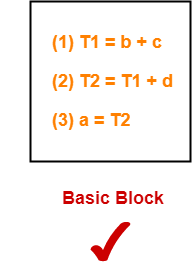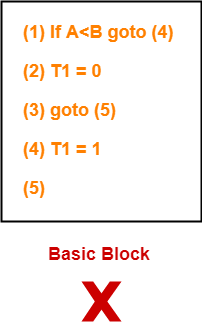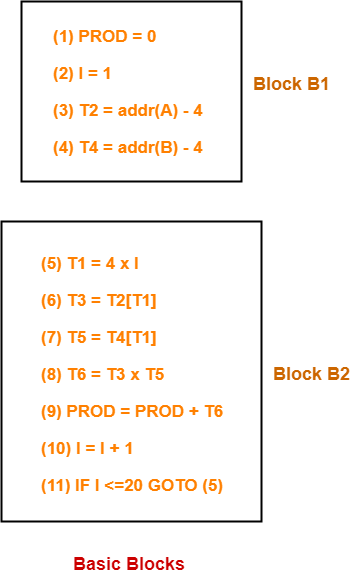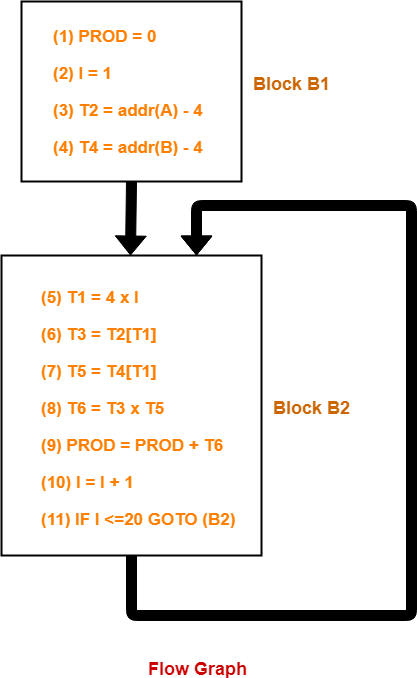Basic block
wikipedia Basic block
In compiler construction, a basic block is a straight-line code sequence with no branches in except to the entry and no branches out except at the exit.[1][2] This restricted form makes a basic block highly amenable to analysis.[3] Compilers usually decompose programs into their basic blocks as a first step in the analysis process. Basic blocks form the vertices or nodes in a control flow graph.
Definition
The code in a basic block has:
- One entry point, meaning no code within it is the destination of a jump instruction anywhere in the program.
- One exit point, meaning only the last instruction can cause the program to begin executing code in a different basic block.
Under these circumstances, whenever the first instruction in a basic block is executed, the rest of the instructions are necessarily executed exactly once, in order.[4][5]
The code may be source code, assembly code or some other sequence of instructions.
More formally, a sequence of instructions forms a basic block if:
- The instruction in each position dominates, or always executes before, all those in later positions.
- No other instruction executes between two instructions in the sequence.
This definition is more general than the intuitive one in some ways. For example, it allows unconditional jumps to labels not targeted by other jumps. This definition embodies the properties that make basic blocks easy to work with when constructing an algorithm.
The blocks to which control may transfer after reaching the end of a block are called that block's successors, while the blocks from which control may have come when entering a block are called that block's predecessors. The start of a basic block may be jumped to from more than one location.
gatevidyalay Basic Blocks and Flow Graphs | Examples
Basic Blocks
Basic block is a set of statements that always executes in a sequence one after the other.
The characteristics of basic blocks are
- They do not contain any kind of
jumpstatements in them. - There is no possibility of branching or getting halt in the middle.
- All the statements execute in the same order they appear.
- They do not lose lose the flow control of the program.
NOTE: 有点原子的含义
Example Of Basic Block
Three Address Code for the expression a = b + c + d is-

Here,
- All the statements execute in a sequence one after the other.
- Thus, they form a basic block.
Example Of Not A Basic Block
Three Address Code for the expression If A<B then 1 else 0 is-

Here,
- The statements do not execute in a sequence one after the other.
- Thus, they do not form a basic block.
Partitioning Intermediate Code Into Basic Blocks
Any given code can be partitioned into basic blocks using the following rules
Rule-01: Determining Leaders
Following statements of the code are called as Leaders
- First statement of the code.
- Statement that is a target of the conditional or unconditional
gotostatement. - Statement that appears immediately after a
gotostatement.
Rule-02: Determining Basic Blocks
- All the statements that follow the leader (including the leader) till the next leader appears form one basic block.
- The first statement of the code is called as the first leader.
- The block containing the first leader is called as Initial block.
Flow Graphs
A flow graph is a directed graph with flow control information added to the basic blocks.
- The basic blocks serve as nodes of the flow graph.
- There is a directed edge from block
B1to blockB2ifB2appears immediately afterB1in the code.
PRACTICE PROBLEMS BASED ON BASIC BLOCKS & FLOW GRAPHS
Problem-01:
Compute the basic blocks for the given three address statements
(1) PROD = 0
(2) I = 1
(3) T2 = addr(A) – 4
(4) T4 = addr(B) – 4
(5) T1 = 4 x I
(6) T3 = T2[T1]
(7) T5 = T4[T1]
(8) T6 = T3 x T5
(9) PROD = PROD + T6
(10) I = I + 1
(11) IF I <=20 GOTO (5)
Solution
We have-
PROD = 0is a leader since first statement of the code is a leader.T1 = 4 x Iis a leader since target of the conditional goto statement is a leader.
Now, the given code can be partitioned into two basic blocks as-

Problem-02:
Draw a flow graph for the three address statements given in problem-01.
Solution
- Firstly, we compute the basic blocks (already done above).
- Secondly, we assign the flow control information.
The required flow graph is-
